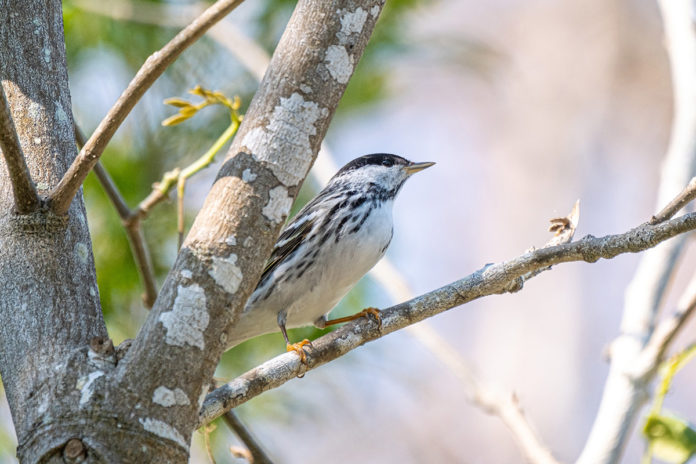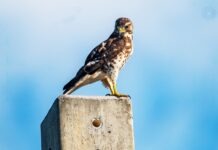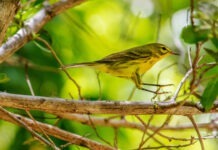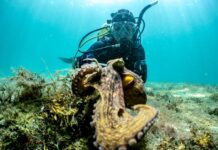A male blackpoll warbler is easily identified by the black cap that makes it resemble Moe from the Three Stooges or, arguably, me, intermittently, from 1970 to 1982, though I was a less snappy dresser. Female blackpolls, which don’t have a cap, are a little trickier, and every spring I experience a moment of avian vertigo when I see the first one of the year and can’t remember what it is. Then I notice the legs.
Most warblers have rather unremarkable legs and they range from black to yellow-greenish, but blackpolls of both sexes have these bright yellow-pinky-orange gams that are hard to miss. Once you clue into it, you can’t really confuse them with anything else, though compared to photos, the distinction is a little more obvious in real life.
I’ve been seeing blackpolls around town for the last week or so — maybe one out of every 20 warblers I come across. (They really like the lacy, small-leafed branches of acacia trees.) They tend to be the caboose of the migration train, so that ratio will most likely increase until mid-May, when it will seem as if there are more blackpolls than anything else.
I try not to freight birds with too many human notions, but whenever I see a blackpoll, it is hard not to think of them as both tiny exemplars of high-endurance bad-assery as well as harbingers of ornithological dispute. In my mind it is the blackpoll conundrum, even though it sounds a bit like a bad spy novel that could be made into a good Matt Damon movie.
The general paradigm in bird migration is that birds take more risks in the spring than in the fall. In the spring, they’re competing, trying to get north and to their breeding grounds as quickly as possible to secure a good territory, find a mate and raise a clutch or two of offspring. In the fall, they want to make good time, but really, once they get to their wintering grounds, they’re mostly going to loaf, so the pressure is off, or at least greatly reduced.
Warblers are songbirds, and the Keys are kind of a migratory nexus for many of them – their last stop before they leap over to Cuba and the Caribbean on the way south, and the first stop when they come out of the Caribbean on the way north. Most of the species we see come through in both seasons.
We never really see blackpolls in the Keys in the fall, though. In fact, hardly any blackpolls are seen anywhere south of Cape Hatteras in the fall, which is weird for a bird that primarily breeds in Northern Canada and Alaska and winters predominantly in Colombia and Venezuela. Sightings data make it pretty clear that they migrate up through the Caribbean in the spring with many other warblers, but how do they get to South America in the first place?
I’m not sure who first proposed it, but eventually a hypothesis developed that the birds, which were seen in the greatest numbers in New England that time of year, just flew straight across the ocean, a distance of 1,600 to 2,000 miles, something that could require multiple days of non-stop flight. Which seemed kind of impossible for a 6-inch bird with a 9-inch wingspan. How could they even have the energy?
For some people it was the only clear answer. For others, there had to be some other explanation.
The leader of the trans-oceanic camp was a man named Dr. Ian C.T. Nisbet. The leader of the skeptics camp was Dr. Bertram G. Murray Jr. For close to three decades the two battled it out on the pages of scientific journals over how these small birds were getting to South America.
Nisbet and his collaborators built the case for overseas flight, citing radar tracking, moon watching, banding recoveries, tower kills, mist net reports, and observations by ship captains, birders and scientists in places like Bermuda and Puerto Rico. Murray essentially said “Bah!” and went on to deconstruct Nisbet et al’s hypotheses, criticizing their small sample sizes, and offering the occasional alternative hypothesis, including the suggestion that maybe birders and scientists in the southern states were misidentifying all the blackpoll warblers as yellow-rumped warblers.
In 1988 Murray published a paper that seemed intended as a door slam, writing, “There is no unequivocal evidence that any blackpoll warblers migrate over the sea directly from New England to South America and all evidence is consistent with the hypothesis that blackpoll warblers migrate to South America through the southeastern United States.”
In 1995 Nisbet and several co-authors clapped back with a paper that called Murray out by name in the title – “Transoceanic Migration of the Blackpoll Warbler: Summary of Scientific Evidence and Response to Criticisms by Murray” – and accused him of misstating and misrepresenting some information, outright ignoring dozen of published papers, and relying on “outdated, unreliable, and/or undocumented” facts. That seemed to end the dispute, as neither Murray nor Nesbit published anything more on the matter.
While few things in science are ever taken as gospel, the theory that blackpoll warblers migrate straight across the ocean from New England to South America is pretty well accepted at this point. (It’s thought that a small number of them may take the less direct southern route.) This was bolstered in recent years by studies in which very small electronic geolocators were attached to blackpolls in Nova Scotia and Vermont just before the fall migration.
Birds were tracked flying directly from New England to Puerto Rico – 1,400- to 1,700-mile flights that took two-and-a-half to three days. The birds then continued on to South America.
A later study showed that birds that bred in Alaska and Western Canada, instead of taking the more direct overland route through Central America, flew up to 3,000 miles across the continent to the northeastern Atlantic Coast, and then made the trans-oceanic flight. Mist net captures (and releases) show the birds usually double their weight before the flight, then burn it off in transit.
It’s hard to figure out the cost-benefit analysis of such a risky southbound route, which may be the driving force behind some scientists’ earlier incredulity. But it’s harder to see a blackpoll warbler flitting around in the trees at Fort Zach and not view them with a serious amount of awe and respect.


























